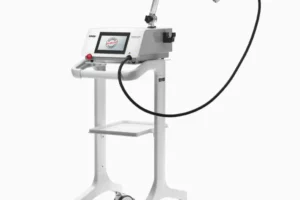[vc_row][vc_column][vc_column_text]“Doctor, I’ve got a pain in my foot”, “sounds like you’ve got plantar fasciitis!”
The most common cause of heel pain in adults is plantar fasciitis, which is reported to affect around 10% of the population. The condition is characterised by intense pain on the inside of the heel when you take your first step out of bed in the morning, or after you’ve had a long period of rest. Plantar fasciitis usually comes on quite suddenly and usually there is a preceding event that triggers it which I refer to as “the straw that broke the camel’s back”… !
Most people describe the symptoms associated with Plantar Fasciitis as sharp, stabbing or burning and after a few minutes of moving around the intensity of the pain subsides somewhat leaving a general bruised feeling which worsens with prolonged weight bearing activity. Sometimes the pain is localised to the arch of the foot.
In most cases there are no physical signs of injury, which is slightly confusing to the person suffering as it feels like the area should be red, bruised or swollen. It almost seems unfair that there is nothing visible to show for it!
Many people make the mistake of thinking that plantar fasciitis will subside within a few days. The reality is that it can take several weeks or months to resolve and without treatment can persist for several years and become quite disabling. I remember hearing a tongue in cheek reference once that “the best cure for plantar fasciitis is the NHS waiting list”. Sadly the joke at the time was that you could be waiting as long as a year for treatment and often cases would resolve on their own within this time or people would seek out self treatment in desperation.
Despite plantar fasciitis being the most common cause of heel pain, it is often misdiagnosed which can be a major contributing factor to poor responses to treatment. If this is the case, it is vital to seek an opinion from a Musculoskeletal Podiatrist who is able to differentiate between the different causes of heel pain. Depending on where you are in the country, your GP may be able to refer you to a Podiatry service, otherwise you will need to look within the private healthcare sector.
Other causes of heel pain include: nerve impingements, inflammation of the fatty padding in the heel, heel bone stress fractures as well as injury to other tendons and ligaments in close proximity to the heel and ankle. It is these less common diagnoses that are often overlooked and under treated which can result in worsening of the condition or cause other problems to arise in other areas of the foot and ankle.
“I am an Advanced Musculoskeletal Podiatrist with special interests in extracorporeal shockwave therapy, video gait analysis and lower limb tendon and fascia injuries. I provide consultancy services to Electromedical Systems on their extracorporeal shock wave machines and am the UK trainer for the Optogait video gait analysis system for Algeos Ltd. My experience extends to providing specialist consultancy and management of lower limb conditions to elite and professional athletes, military personnel, recreational sports people and the general population. My purpose is to improve my patient’s’ quality of life and get them back to achieving their goals whether it’s walking the dog, getting through a compulsory fitness test, running a marathon or competing in an international event.” Emily Ball, Clinical Director, Active Step Healthcare Ltd.
Active Step Podiatry is based in Whiteley, Hampshire covering Fareham, Southampton & Portsmouth.
[/vc_column_text][/vc_column][/vc_row][vc_row][vc_column][vc_empty_space height=”40px”][ult_buttons btn_title=”Click Here to Read Part 3″ btn_link=”url:https%3A%2F%2Fwww.activestep.co.uk%2Fintroducing-heel-pain-part-3-4%2F|title:Heel%20Pain%20Part%203%20%26%204||” btn_align=”ubtn-center” icon_size=”32″ btn_icon_pos=”ubtn-sep-icon-at-left”][vc_empty_space height=”40px”][/vc_column][/vc_row]



